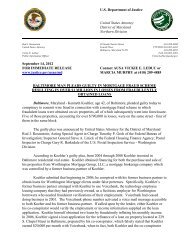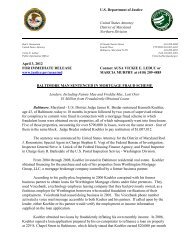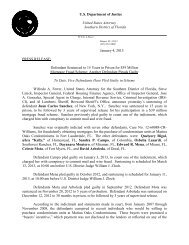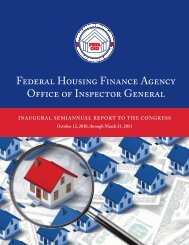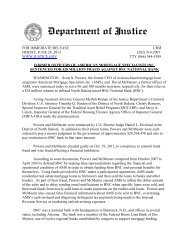FEDERAL
Sixth Semiannual Report to the Congress - Federal Housing ...
Sixth Semiannual Report to the Congress - Federal Housing ...
- No tags were found...
Create successful ePaper yourself
Turn your PDF publications into a flip-book with our unique Google optimized e-Paper software.
Appendices<br />
Appendix A:<br />
Glossary and Acronyms<br />
Glossary of Terms<br />
Alternative A: A classification of mortgages in which<br />
the risk profile falls between prime and subprime.<br />
Alternative A (also known as Alt-A) mortgages are<br />
generally considered higher risk than prime due to<br />
factors that may include higher loan-to-value and<br />
debt-to-income ratios or limited documentation of<br />
the borrower’s income.<br />
Bankruptcy: A legal procedure for resolving debt<br />
problems of individuals and businesses; specifically, a<br />
case filed under one of the chapters of Title 11 of the<br />
U.S. Code.<br />
Basis Points: Refers to hundredths of 1 percentage<br />
point. For example, 1 basis point is equivalent to<br />
1/100 of 1 percentage point.<br />
Bonds: Obligations by a borrower to eventually<br />
repay money obtained from a lender. The bondholder<br />
buying the investment is entitled to receive both<br />
principal and interest payments from the borrower.<br />
Capital Gain (Loss): When a capital asset (e.g.,<br />
stocks or bonds held as investments) is sold, the<br />
difference between the amount paid for the asset<br />
and the amount it is sold for is a capital gain or loss.<br />
Capital gains occur when the asset sells for more than<br />
paid, while capital losses occur when the asset is sold<br />
for less than the purchase price.<br />
Capitalization: In the context of bank supervision,<br />
capitalization refers to the funds a bank holds<br />
as a buffer against unexpected losses. It includes<br />
shareholders’ equity, loss reserves, and retained<br />
earnings. Bank capitalization plays a critical role in<br />
the safety and soundness of individual banks and the<br />
banking system. In most cases, federal regulators set<br />
requirements for adequate bank capitalization.<br />
Carryforwards: A provision of tax law that allows<br />
current losses or certain tax credits to be utilized in<br />
future tax returns.<br />
Collateral: Assets used as security for a loan that can<br />
be seized by the lender if the borrower fails to repay<br />
the loan.<br />
Commercial Banks: Commercial banks are<br />
establishments primarily engaged in accepting<br />
demand and other deposits and making commercial,<br />
industrial, and consumer loans. Commercial banks<br />
provide significant services in originating, servicing,<br />
and enhancing the liquidity and quality of credit that<br />
is ultimately funded elsewhere.<br />
Conforming Loan: A conforming loan is a<br />
conventional loan with an origination balance that<br />
does not exceed a specified amount (i.e., conforming<br />
loan limit). The enterprises are restricted by law to<br />
purchasing conforming loans, with the loan limits<br />
varying by unit size and region, e.g., high-cost areas.<br />
For 2013, the maximum general loan limit for a<br />
single-family one-unit dwelling is $417,000, while<br />
the maximum high-cost area loan limit for a singlefamily<br />
one-unit dwelling is $625,500.<br />
Conservatorship: Conservatorship is a legal<br />
procedure for the management of financial<br />
institutions for an interim period during which the<br />
institution’s conservator assumes responsibility for<br />
operating the institution and conserving its assets.<br />
Under the Housing and Economic Recovery Act of<br />
2008, the enterprises entered into conservatorships<br />
72 Federal Housing Finance Agency Office of Inspector General



